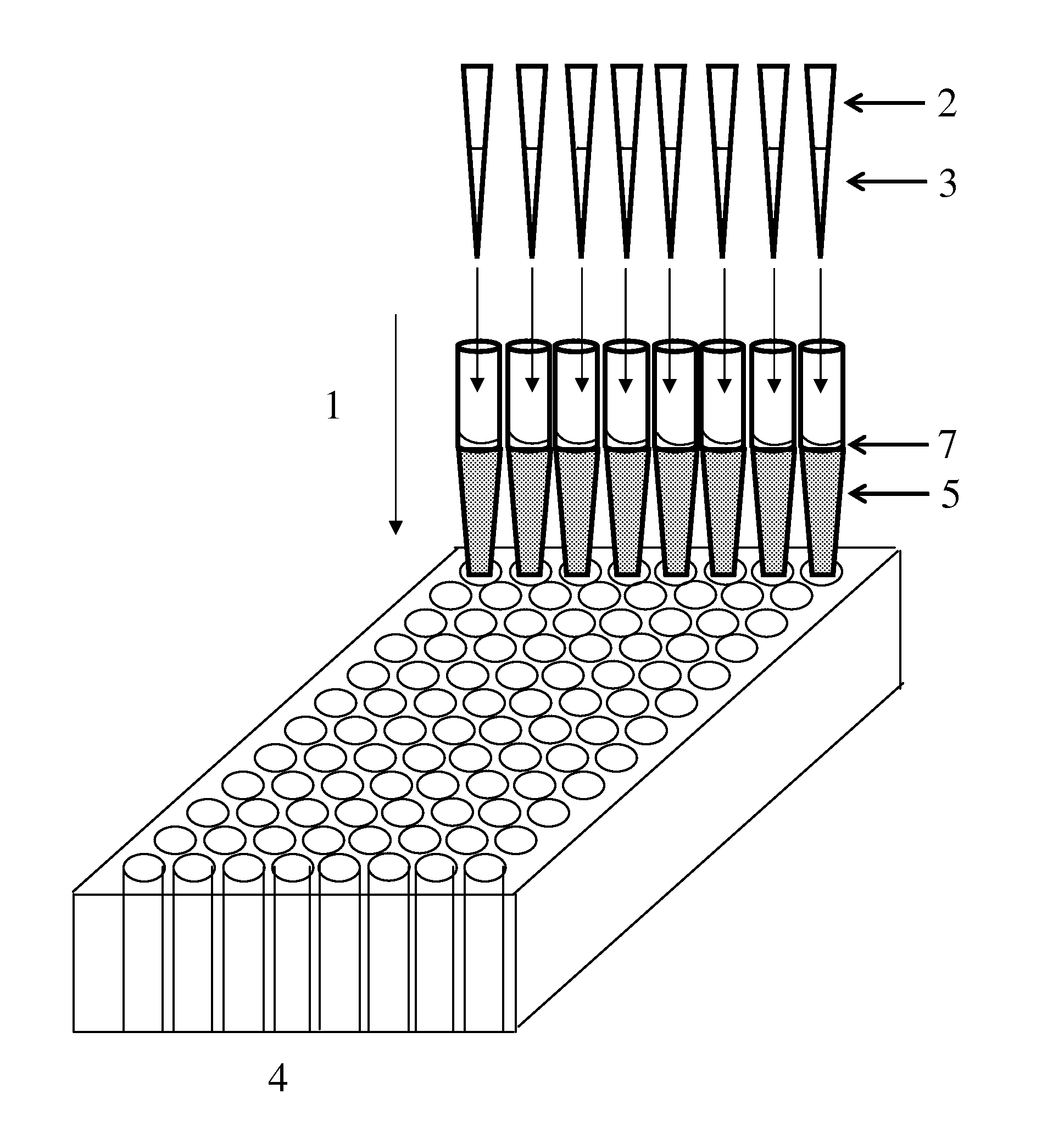Method and Device for Gravity Flow Chromatography
a gravity flow chromatography and flow chromatography technology, applied in the separation of components, chemical/physical processes, peptides, etc., can solve the problems of large amounts of purified materials, prohibitive cost of owning several instruments, and large volume of purified materials
- Summary
- Abstract
- Description
- Claims
- Application Information
AI Technical Summary
Benefits of technology
Problems solved by technology
Method used
Image
Examples
example 1
Preparation of Gravity Chromatography Column Bodies from Pipette Tips
[0227]One 200 μL and two 1000 μL polypropylene pipette tips of the design shown in FIG. 9 (Rainin, Alameda, Calif., PN RT-L250W, RT-L1000W and RT-L1200) were used to construct four chromatography columns. In this example, four columns were constructed: an 80 μL bed in a 200 μL column and 200, 600 and 900 μL bed volumes in a 1000 μL column. To construct a column, various components were made by inserting the tips into several custom aluminum cutting tools and cutting the excess material extending out of the tool with a razor blade to give specified column lengths and diameters.
[0228]Referring to FIG. 10, the first cut 92 was made to the tip of a pipette tube 90 to form a 3 mm, 4.57 mm, 4.57 mm and 6 mm outside diameter hole 94 on the lower column body, which corresponds to the 80, 200, 600 and 900 μL columns, respectively. A second cut 96 was made to form an inner column body segment 98 having a length of 3.0 mm, 10...
example 2
Desalting a Protein Sample of Imidazole by Size Exclusion
[0232]A method and apparatus for desalting a protein sample by size exclusion is depicted in FIG. 8. A desalting tip column is prepared using the methodology provided herein in Example 1. The chromatography column 406 is about 100 μL and is packed with a size exclusion media suitable for desalting a protein of interest, e.g., Sephadex G-10, G-15, G-25, G-50 or G-75 (Amersham Biosciences, Piscataway, N.J.). The specific size exclusion media employed will vary depending upon such factors as the size of the protein to be desalted, the nature of constituents of the solution to be desalted, and requirements such as desired speed of the process, yield of product, concentration of product, degree of desalting, etc., as can be determined by one of skill in the art based on the known properties of size exclusion media such as Sephadex.
[0233]The size exclusion resin is hydrated with water, or optionally with a buffer such as PBS. Prior ...
example 3
Automation of the PhyTip Gel Filtration Column
[0240]PhyTip gel filtration columns (PhyNexus, Inc., San Jose, Calif.) are compatible with use on the PhyNexus MEA Personal Purification System and the Beckman Biomek FX. With some modification, the columns can be made compatible with most 96-channel liquid handling instruments. Four steps are required for use of the PhyTip gel filtration columns for size-based separations. These steps are column equilibration, column conditioning, sample loading and collection of target molecule(s).
[0241]PhyTip column equilibration. The PhyTip columns are shipped with glycerol, which acts as a preservative and prevents the media from dehydrating. The glycerol needs to be removed prior to use of the columns. To remove the glycerol, the end of the PhyTip columns are submerged in buffer such as water supplemented with 0.01% sodium azide to act as a preservative. 1 mL of this buffer is added to the top of the columns and these are allowed to equilibrate for...
PUM
| Property | Measurement | Unit |
|---|---|---|
| distance | aaaaa | aaaaa |
| volume | aaaaa | aaaaa |
| volume | aaaaa | aaaaa |
Abstract
Description
Claims
Application Information
 Login to View More
Login to View More - R&D
- Intellectual Property
- Life Sciences
- Materials
- Tech Scout
- Unparalleled Data Quality
- Higher Quality Content
- 60% Fewer Hallucinations
Browse by: Latest US Patents, China's latest patents, Technical Efficacy Thesaurus, Application Domain, Technology Topic, Popular Technical Reports.
© 2025 PatSnap. All rights reserved.Legal|Privacy policy|Modern Slavery Act Transparency Statement|Sitemap|About US| Contact US: help@patsnap.com



